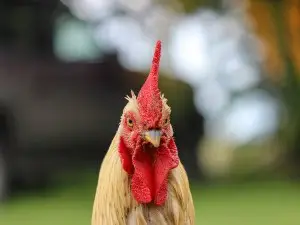
Maintaining a good healthy flock is important, if one of your birds gets sick, this bird can infect the rest of the flock very quickly if the sick bird has something contagious.
This article looks at why your chicken has a lump on its beak
Table of Contents
Lump on chicken’s beak:
Diseases in chickens can show up in a variety of ways, the sudden development of lumps is a sign that something wrong is going on with your bird.
Here are a few reasons why your chicken may have developed a lump on its beak:
An insect bite:
Insects are happy to bite any animal that they see fit, and sometimes, an insect may bite a chicken’s beak.
Insects like spiders, hornets, bees, or wasps can bite your chicken’s beak and you may only realize this when you have a look at your bird’s beak and see the lump.
Your bird will likely not make a fuss if it gets an insect bite, these birds have evolved to not show signs of injury or distress.
A chicken showing signs of injury or distress, out in the wild, would be a signal that the animal is weak.
Showing signs of weakness in the wild would make the bird a target for predators. This is why chickens evolved to not show signs of suffering as best they can.
While you won’t see any suffering, you will see a lump on the bird’s beak if bitten by an insect
An insect getting close to a bird, and biting it, is a huge risk, it doesn’t always happen but it does sometimes happen.
What to do:
Keep an eye on your bird after the insect bite, if the bird seems to be unbothered by the insect bite then you can leave the chicken alone.
If the bird starts to show signs of sickness then it is recommended that you take the bird to a vet, an avian vet is preferred but a general vet will also be a good bet
Abscess:
Abscesses can develop almost anywhere on a bird’s body, the beak included. Objects on your property, like splinters of wood, could have pierced the bird’s beak and caused the abscess.
When birds become injured and an infection starts to develop, the area starts to swell as the immune system sends white blood cells to the area.
Nearby tissue starts to die as the cells fight the foreign bacteria. This creates an opening that fills with pus and an abscess develops.
If your bird does have an abscess, then the bird will look and feel poisoned, it will have sunken eyes, its feathers may be fluffed up and its eyes may be partially lidded.
What to do:
You can leave the abscess alone to drain on its own, or, you can drain it yourself.
If you choose to leave it alone then applying a warm compress to the bird’s abscess should help it drain itself. The abscess should start to shrink as you regularly apply a warm compress onto it.
If you decide to lance the abscess, it would be better to pick the scab off and drain the abscess from there rather than making a new cut on the lump.
Papillomavirus:
A bird that has a lump on its beak may have a disease called cutaneous papillomatosis.
This disease affects not only chickens, but it also affects African grey parrots, cranes, cockatiels, budgies, and finches.
This disease causes the growth of non-cancerous masses called papilloma. These growths can appear on your bird’s beak as well as on your bird’s wings, neck, legs, and feet.
One wart may develop on the bird’s beak or a few warts may develop on other areas of the bird’s body. If the lump on your bird’s beak has a cauliflower appearance then you can assume that this is what’s wrong with your bird.
What to do:
If the wart is disturbing your bird, then you can take your bird to the vet for treatment. The vet will be able to remove the wart from your bird’s beak.
These warts can be removed using radiosurgery or cauterization. Unfortunately, even after successfully removing the wart from your bird’s beak, the wart/s may reappear
FAQ:
Why is my chicken’s beak turning black?
The reasons why your chicken’s beak is turning black may be because the animal has some sort of infection, or injury or the skin is dying.
In most cases, the black skin will usually slough off and the beak should go back to looking normal.
Consulting with a vet for some antibiotics would be helpful if the beak has an infection.
What does an unhealthy bird beak look like?
Signs that your bird’s beak is unhealthy include unusual flaking, a misalignment of the beak, cracks, discoloration, or excessive growth at the beak.
The reason for this could be a number of things so taking your pet to be examined by a vet is recommended.
If you enjoyed this article then you may also be interested in other bird related articles. Here are some articles that you may be interested in: Black Scabs On Chicken Comb, Sores On Chicken’s Comb, Wart On Chicken Beak

